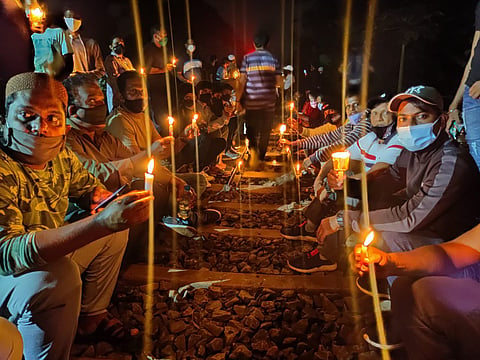

More than 30 wildlife scientists on Monday came together to critique the Wildlife Institute of India (WII), an autonomous institution under the Union Ministry of Environment Forest and Climate change, for okaying the controversial Goa-Karnataka (Vasco-Hospet) railway doubling project. These scientists include faculty and researchers of eminent institutions like the Indian Institute of Science and National Institute of Advanced Studies in Bengaluru, Yale University, WII, University of Michigan, as well as several independent researchers and scholars.
The proposed project will involve doubling of the railway line from Tinaighat to Castle Rock in Uttara Kannada district to Caranzol in south Goa. The proposed alignment will require the diversion of 138 hectares of forests in Goa through Mollem National Park and Wildlife Sanctuary(120 hectares), and another 10 hectares through Kali Tiger Reserve in Karnataka.
The Kali Tiger Reserve is an important habitat for tigers, leopards, elephants, bison, wild dogs, sambars, spotted deer, sloth bears, wild boars, hanuman langurs, bonnet macaques and several other mammals, as well as varieties of reptiles and birds including all four species of the hornbill. The wildlife scientists feel that felling trees for the railway project will lead to irreversible loss of habitat, especially for the tigers, and can even lead to extinction of some species.
In a detailed open letter addressed to Dhananjai Mohan, Director, Wildlife Institute of India (WII) and other top officials of the Union Forest, Railway department and Karnataka forest department, the scientists said that the wildlife clearance given to the project was “not based on rigorous scientific data and lacks information in several aspects”. They relied on several peer reviewed research journals to make their arguments. Incidentally a recent Right to Information reply has also revealed that the WII, which enjoyed a good reputation, has been struggling due to lack of government funding.
Several people have been opposing the proposed NH-4 expansion and laying of 400 KV electric transmission lines in the forest area as well. Other than the environmental and wildlife aspects, the area is also a watershed region of many rivers.
Also read: Karnataka HC slams NHAI for bizarre claim that ‘anti-national’ NGOs opposing road project
The letter mentions the WII’s suggestion of making mitigation structures along the railway line, which could help restore connectivity between forest patches while reducing wildlife mortality due to vehicular collision at the same time. These structures include culverts, underpasses, overpasses and level crossings.
But the wildlife scientists are not convinced. They say, “However, a detailed review of this report reveals that the mitigation recommendations are not based on rigorous scientific data and lack information in several aspects. The rapid manner in which the study seems to have been conducted raises doubts about the accuracy and reliability of the data and the ensuing mitigation measures suggested,” adding that the study lacks reliable information on animal movement. The letter further says that the proposed NH-4 expansion project within a few kilometres of the railway line will further fragment the local ecosystem. It also points to research that states the Kali Tiger Reserve is a particularly important corridor for movement of animals like Gaur and sloth bears.
Other than this, the scientists allege that the WII’s survey methodology is faulty. They targeted the wildlife mitigation study that was carried out over just 15 days, during which camera traps failed to identify a single tiger in the region, when All India Tiger Estimation (AITE) surveys say otherwise. The letter also accuses the WII of ignoring their own 2016 report titled ‘Eco-Friendly Measures to Mitigate Impacts of Linear Infrastructure on Wildlife’.
Another aspect that the letter says is ignored, is the presence of elephants. The WII’s 2016 report states that if elephants are present in the habitat, the minimum height for the underpasses should be at least 6m-8m. However, none of the current proposed underpasses are above 5m.
The letter also says to consider the habitat of the hornbill, which are endangered to critically endangered and are mostly found in the Western Ghats in India.
A recent RTI filed by environmental lawyer Sreeja Chakraborty has revealed that more than Rs 36.5 lakh was given for the WII’s study by the Indian Railways. Moreover, it was prepared based on the IISc’s Environmental Impact Assessment data, which scientists had earlier critiqued for lack of reliability.
Speaking with TNM, Sreeja said, “WII has been now forced to toe the Union government’s line and have been stripped of government funding in October 2020. This has meant that WII is now charging money from project proponents to prepare reports/EIA’s for project proponents seeking wildlife clearances from the Central Government’s Wildlife Committee headed by Union Environment Minister Prakash Javadekar. This amounts of clear ‘conflict of Interest’.”